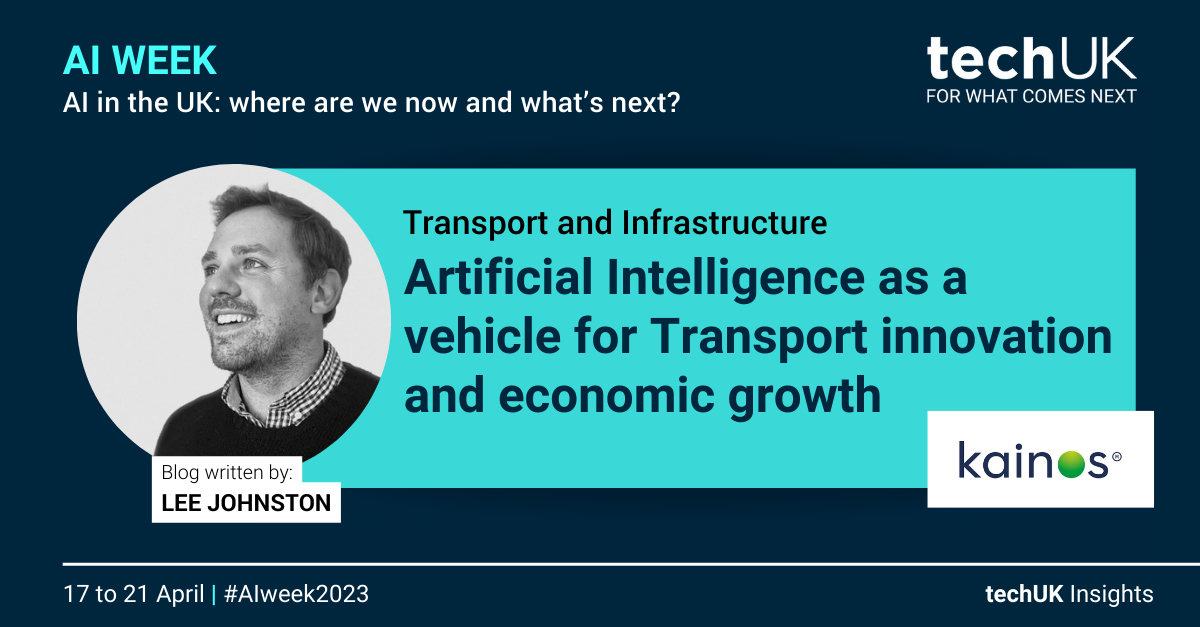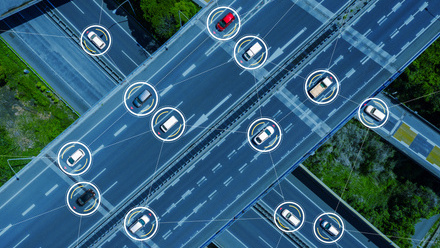Artificial Intelligence as a vehicle for Transport innovation and economic growth (Guest blog Kainos)
The transport ecosystem is an essential part of the country's infrastructure, facilitating the movement of people and goods across the nation, however these essential services are under threat due to increased pressures on demand, congestion, aging infrastructure, and rising costs.
Mark Harper, Transport Secretary, recently announced there is over £40 billion to be invested in transformational transport schemes over the next two financial years. With AI revolutionising the way we live, work, and move around cities, how can the Transport sector leverage this investment and harness AI to help optimise operations, reduce environmental impact, and improve efficiency to provide better public services?
In this blog I will discuss 7 ways AI can help reduce these increased pressures.
-
Predictive Maintenance
Transport infrastructure requires maintenance to function efficiently and effectively. AI can be used to predict the maintenance needs of vehicles and infrastructure by monitoring data such as engine performance, tyre pressure, component wear, and fuel consumption. These algorithms can help us detect potential issues and alert maintenance teams to take proactive measures thus minimising downtime, reducing repair costs, improving safety and prevent major disruption or accidents from occurring.
A recent market study conducted by Transparency Market predicts that between 2019 and 2027, the automotive predictive maintenance market will expand 28% globally with the demand for connected mobility being a key driver for growth.
-
Traffic Management
Traffic congestion costs time, money, harms the environment, and causes unnecessary stress to drivers and passengers. No matter where you are in the UK, you are almost guaranteed to experience delays by road, sea, or rail due to commuter traffic, planned or ah-hoc maintenance and accidents.
By analysing traffic density, historic/real-time traffic patterns and event information (e.g., concerts or construction), AI can begin to inform decision making on traffic signalling, rerouting, and scheduling earlier which can help reduce bottlenecks, optimise traffic flow, reduce congestion, and minimise travel time.
Transport for London (TfL) uses AI to predict congestion hotspots and adjust signals to ease traffic flow thus improving how people and goods move around the capital's road network safely and efficiently. This project has saved more than £100m in lost travel time since starting. Additionally, sensors can be used to monitor traffic conditions, providing data in real time could alert authorities of accidents and help providers improve how they manage congestion.
-
Demand Forecasting
AI can help forecast demand, allowing transport providers to optimise their services and manage people and assets more efficiently. Through leveraging a wide range of data sources such as weather patterns, events, and public holidays, AI can accurately predict travel behaviour and demand for a specific period allowing providers to adjust services accordingly. For example, demand forecasting attempts to answer questions such as:
- How many trips will be made using a specific service / route during a given period?
- Which routes / services will become congested?
- How many passengers will a new transportation service attract?
-
Road Condition and Infrastructure Monitoring
National Highways and local councils monitor road conditions for the Strategic Road Network (SRN) and major traffic dense roads however often on smaller lesser used roads and residential areas it is left up to the public to raise awareness of poor road conditions.
With computer vision and machine learning algorithms, AI can use images from drones or static cameras to automatically detect irregularities on the roads surface and surrounding infrastructure removing the need to conduct analysis at the roadside. This approach allows authorities to take proactive measures to improve road quality whilst increasing the safety of those performing assessments.
-
Supply Chain Optimisation (freight)
The UK transports 1.6 billion tonnes of freight a year using many different modes of transport, contributing significantly to our economy (£127 billion) and carbon emissions.
The UK has ambitions to deliver world-class, seamless flow of freight across the UK’s roads, railways, seas, skies, and canals and has invested £7 million in the uptake of innovative technology, such as AI, to support a more cost-efficient, reliable, resilient and sustainable freight sector.
The solutions mentioned above go part way to addressing the bottlenecks however, unlike passenger routes there could be limitations for freight traffic e.g., height and weight restrictions play a critical factor given transport mode and routes containing bridges or narrow roads. Leveraging AI could help aid route optimisation, predictability, and anticipation of disruption especially with last mile delivery. In addition, with High Speed Two (HS2) on the horizon, now is a good time to understand and build predictions for freight services in the future. In addition, issues at ports and borders are causing substantial delays, AI can expedite laborious route planning, increase transparency, improve the resilience of the supply chain, and help unclog bottle necks to ensure timely deliveries.
-
Service provision (improved scheduling and accessibility)
Everyone should have access to a minimum level of transport services regardless of where they live. However, there is a lack of public transportation routes for people in rural / low-density areas. To prevent against transport poverty and increase fairness in accessibility, AI can unearth trends in public transport provision to people in rural or underserved areas by analysing supply and demand, population density and route analysis.
Furthermore, we can use existing data to better understand gaps in the provision of services to those passengers with mobility, hearing, or visual impairments. By unearthing this data, we can empower suppliers with the information required to help them understand how they could improve transport services for underrepresented groups.
-
Sustainable transport planning
Consumers have become more environmentally conscious especially in their perception of the transportation industries impact on the environment. Yes, much of the transport sector still relies heavily on the consumption of fossil fuels but, how can we reduce reliance? Again, HS2 goes some way to address this with Zero Carbon trains, but it is likely that part of a commuter’s journey will still use fossil fuels. As passengers seek more environmentally favourable routes such as active travel routes (bicycles and scooters), public transport (railway or buses) and even waterways. AI can help providers identify patterns and gaps in travel routes thus enabling providers to offer alternative solutions which in turn can unlock huge efficiencies and reduce emissions. By building an understanding of alternative transport options, AI can also help passengers plan end-to-end journeys across multiple modes of transport more easily, and better yet, calculate emission savings.
Going beyond scratching the surface
AI is already making waves in the transport sector from helping cars, trains, ships, and aeroplanes function autonomously and make traffic flows smoother, but it has only scratched the surface. As AI capabilities and the sector evolve, it is likely that this technology will play an increasingly significant role in shaping the future of transportation including reducing the number of road accidents, boosting operational efficiency, lowering pollution, and making transportation safer for all.
That said, for adoption to be successful, transport providers must take a strategic approach to implementing AI services, and if not already doing so, invest in defining and implementing a data transformation program that will enable and unlock AI capabilities.
Trust, policy, and regulation are some of the challenges that also must be tackled. The UK Government has started looking beyond the short-term agenda and their white paper “a pro-innovation approach to AI regulation” addresses some of the challenges, benefits and effects that AI can have on industry, society and wider economy, and I am genuinely excited to see what the next 6-12 months have in store.
Please get in touch to find out more;
Lee Johnston, Business Development Manager, Data and AI. Lee Johnston | LinkedIn

AI and Data Analytics updates
Sign-up to our monthly newsletter to get the latest updates and opportunities from our AI and Data Analytics Programme straight to your inbox.







